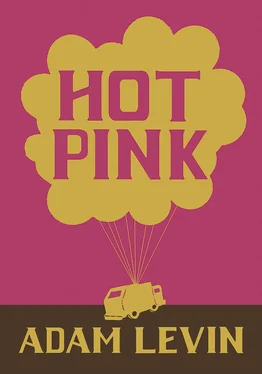What Susan Falls is considering for extra credit: how Adam, who was born a man, and who, without his Eve, without knowing he was a male in the male/female dichotomy — and so knowing nothing of human reproduction — could know that other men would come from him, rather than from the word of God, where Adam had come from.
As the limo exits the Drive at 55th, Susan sets the extra credit aside for later consideration and begins to write in the margins of Genesis Rabbah. While doing so, she is struck by the idea that Adam might be a lot like her — his seventy years her lower body, David her brain. Some time, early on, when she knew things in a pure sense, she might have made a deal with God, an investment of her earthly legs in a transcendent mind with high-capacity intellect. It was pretty to think so.
So pretty, in fact, that she doesn’t realize the limo has stopped, has been stopped for minutes, until Jake, the driver, lowers the separator and pronounces her name. “Susan,” he says, “are you not well? Would you like me to wheel you to class today?”
CHAPTER 130,023
CONSIDERING THE UTILITY OF BLUE SNOWPANTS
Susan Falls thinks Carla Ribisi has a big ass and that Carla Ribisi’s big ass is beautiful and that Carla does not know it. And Carla Ribisi is always wearing blue nylon snowpants. The intended effect of the snowpants is to disguise the bigness of the ass in bigger-ness, Susan Falls thinks. It is a complicated trick. It begins with a syllogism. The first premise is that anyone who wears snowpants appears to have a big ass:
1. Anyone who wears snowpants appears to have a big ass.
2. Carla Ribisi wears snowpants.
. .. Carla Ribisi appears to have a big ass.
The trick comes of the word appears. Appears allows for, but does not necessitate, visual trickery. Things that allow for but do not necessitate other things are tricky, and tricky things engender consideration. Things that allow for but do not necessitate trickery itself are even trickier, and these things engender much richer consideration. The richer the consideration engendered by a thing, the longer the time one will spend considering that thing. Consider the following hypothetical situation:
Susan Falls has just started dating Carla Ribisi, and the two go shopping for a T-shirt for Carla. They go into the changing room and Carla tries on one of two stretchy V-necks she’s deciding between, a red one, say, a warm kind of red, like that of the hair under Susan’s arms. The T-shirt looks good and Susan Falls tells Carla Ribisi that the T-shirt looks good.
Carla tells Susan Falls that this is the first time she’s shared a changing room with another woman since the long-lost days when she used to shop at indoor malls with her mother. Susan Falls blushes. Carla Ribisi removes T-shirt #1, and, reaching for T-shirt #2, looks at Susan Falls, longingly(?), and says, “Blusher.”
Being called on blushing causes dollar-coin-size spots of the same shade of blush as Susan Falls’s face to appear on Susan Falls’s neck.
Carla pulls her head up through T-shirt #2. “I’m sorry,” she says to Susan Falls. “I didn’t mean to make you embarrassed when I said you were a blusher.”
The dollar coins darken in time with Susan’s ecstasy.
Susan’s ecstasy is like neither a balloon nor a hat pin, but like a hat pin’s entrance and movement, under the guidance of a cotton-gloved birthday clown, through the skin of a balloon.
There is something that is so Goddamned hot about Carla Ribisi considering and, further, discussing any effect that she has had on Susan Falls. Let alone in a Nordstrom dressing room, trying on T-shirts.
T-shirt #2 looks good, but in a different way than the way in which T-shirt #1 looked good.
“So?” Carla wants to know.
“It looks good,” Susan says. “It makes your tits look bigger.”
“Hmm.” Carla doesn’t know if she likes that. She has big-enough-looking tits already. Showing them off, she has decided at different times in her past, makes her look trampy. “That’s good?” she says. “That it makes my tits look bigger?”
“You have beautiful tits, Carla. The T-shirt just brings it out.”
“Do you mean to say that my tits are essentially beautiful, and that the appearance of more of my tits reveals more essential beauty?”
“Yes!” Susan says, now thrilled to damp underthings by Carla’s obsessive parsing and analysis of a sentence Susan has spoken.
“Or do you mean to say,” Carla says, “that my tits are beautiful because they’re big, and therefore my tits, upon looking bigger, appear more beautiful because ‘you can’t get enough of a good thing’—the good thing being the bigness of tits?”
“Are you making fun of me?”
“Not at all. I’m having fun with you. And attempting to choose between T-shirts at the same time. So which T-shirt’s better?”
“I don’t know that we can make informed choices about the T-shirts at this point, because now that we’ve spent so much more time on the one you’re wearing than we did on the first one, we’re probably invested in the one you’re wearing, and—”
“I’m not gonna sweat that, Susan. Which one do you like better?”
“My opinion—”
“Your opinion isn’t founded on a bedrock of rigorous analysis and therefore etc. etc. etc.?”
“You are making fun of me.”
“I’m telling you that I want and will buy the T-shirt that you prefer,” Carla says.
“Are you sure? Because you’re saying it in this way that it sounds like maybe you’re making fun of me.” Susan Falls begins to shiver, and then she begins to cry — not really, but hypothetically.
Susan’s hypotheticals often end sadly and hardly ever make their point with force. Disregarding the ever-present effect that the Wheelchair Factor has on her confidence, the Sadly Ending Hypothetical Factor is the number one reason for why she can’t bring herself to engage Carla Ribisi in conversation. But back to trickery:
The considerer will arrive at two interpretations of “Carla Ribisi appears to have a big ass,” each one implicated by the other:
A. The actual size of Carla Ribisi’s ass cannot be known at this juncture (snowpantsed).
B. Carla Ribisi’s ass is a mystery.
Susan Falls has, by now, watched enough TV and studied enough social and cognitive psychology, she hopes, to soon fulfill her dream of becoming one half of a powerful and revered creative team at Leo Burnett. Susan knows about attribution. She knows self-perception theory. Susan knows that for every considerer, there is a specific amount of time, designated x , that must be spent considering a thing before the considerer becomes aware that she has spent time considering the thing. Moreover, Susan knows that after the considerer has considered an as-yet-neutral (unvalenced) thing for x , that thing will appear to the considerer — unless she is someone who suffers from terribly low self-esteem or clinical depression — to be a good (positively valenced) thing, for the (non-depressed, self-esteeming) considerer knows she wouldn’t spend her time on a thing that wasn’t good. Therefore, once the mystery of Carla Ribisi’s ass has been considered for x, the mystery of Carla Ribisi’s ass is good. And all good mysteries are good to solve, so solving the mystery is also good.
In order to solve the mystery —in order to see Carla Ribisi sans blue snowpants — one would have to spend time with Carla Ribisi, time enough to wind up in places where wearing snowpants would be out of the question: dressing rooms, beaches, showers, etc.
If Carla is a smarty — and Susan is sure that Carla must be, for Susan wouldn’t otherwise waste so much time gawking at and thinking about her — then Carla, to ensure that any given considerer’s x be met or surpassed, would stretch out this getting-to-know-Carla time for as long as possible before letting the considerer see her without snowpants, for in being kept from seeing what Susan will call Carla’s true ass for x or longer, the considerer, always considering, would work the previously outlined self-perception algorithm, but this time the considerer would transpose solving the mystery with true ass , itself, such that not only would to solve be a good thing, but true ass (the solution) would also be good.
Читать дальше











